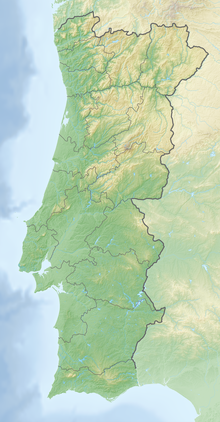Anta dos Pombais
Location of the Anta dos Pombais in Portugal. |
The Anta dos Pombais , also called Anta do Pombal , located on a hill , is a megalithic complex about 2.3 km north of Castelo de Vide, in the municipality ( Portuguese Freguesia ) Santa Maria da Devesa in the district ( Portuguese Concelho ) Castelo de Vide , district Portalegre in the northeast Alentejo .
Anta , Mámoa , Dolmen , Orca and Lapa are the common names in Portugal for the approximately 5000 megalithic structures that were built during the Neolithic in the west of the Iberian Peninsula by the successors of the Cardial or Imprint culture .
Monument preservation
From 1867–1868 the complex was examined and published by Pereira da Costa and in 1910 it was registered and protected as a Monumento Nacional .
In the time before it was placed under protection, the Anta was used as an agricultural building, probably also as a chapel at times . This use led, on the one hand, to the destruction of the existing finds and findings in the ground area, on the other hand, the walls drawn on and between the bearing stones kept the burial chamber from collapsing. Today it is one of the best preserved antas in the region, regardless of the changes due to modern use.
The property is privately owned, but is open to the public and on the trail PR 2 Torrinha ( Portuguese pedestres Percursos ) of Cidade Castelo de Vide, the technicians at the Anta do Pincho and Anta da Casa dos Galhardos are, developed for tourism.
Finding
The polygonal burial chamber with a diameter of about 3.4 m is formed by seven support stones ( orthostats ) made of granite and is closed with a large, protruding capstone. Five of the former seven irregularly square bearing stones are still in situ . The capstone that closes the approximately 3.8 m high grave chamber at the top is also preserved in situ.
So far there has been no evidence of a corridor or a hill ( mámoa ) of the tomb. In the course of the cleaning and inventory work in 2010, no relevant findings could be observed, but only a modern archaeological investigation of the Anta and its surroundings allows a final assessment.
Finds
No information is available about possible finds from the excavation between 1867 and 1868.
Individual evidence
- ↑ a b c Rosário Gordalina: Anta dos Pombais . Direção – Geral do Património Cultural - Sistema de Informação para o Património Arquitectónico, 1991, accessed on July 4, 2018 (Portuguese).
- ↑ a b Archaeological guide through Portugal . In: Thomas G. Schattner (Ed.): Cultural history of the ancient world . tape 74 . Philipp von Zabern, Mainz 1998, ISBN 3-8053-2313-1 , p. 114 .
- ↑ Francisco A. Pereira da Costa: Noções sobre o estado préhistórico da terra e do homem seguidas da descripção de alguns dolmins ou antas de Portugal . Lisbon 1868, p. 90 (Portuguese).
- ↑ Decreto de 16-06-1910. (pdf) In: DG, n.º 136, de 23-06-1910. June 23, 1910, p. 2163 , accessed June 16, 2018 (Portuguese).
- ↑ a b A. Martins: Anta dos Pombais . Direção – Geral do Património Cultural, accessed July 4, 2018 (Portuguese).
- ↑ a b c d Anta dos Pombais . Direção – Geral do Património Cultural - Portal do Arqueólogo, accessed on July 4, 2018 (Portuguese).
- ↑ Torrinha . (pdf) Municipio de Castelo de Vide, accessed on June 16, 2018 (Portuguese).
literature
- A. Martins: Anta dos Pombais . Direção-Geral do Património Cultural, accessed on July 4, 2018 (Portuguese, with extensive literature sv Bibliografia).
- Thomas G. Schattner (Ed.): Archaeological guide through Portugal (= cultural history of the ancient world . Vol. 74). Philipp von Zabern, Mainz 1998, ISBN 3-8053-2313-1 p. 114
Web links
- Anta do Pombal. Retrieved July 4, 2018 .
Coordinates: 39 ° 26 ′ 5.6 " N , 7 ° 27 ′ 41.7" W.
